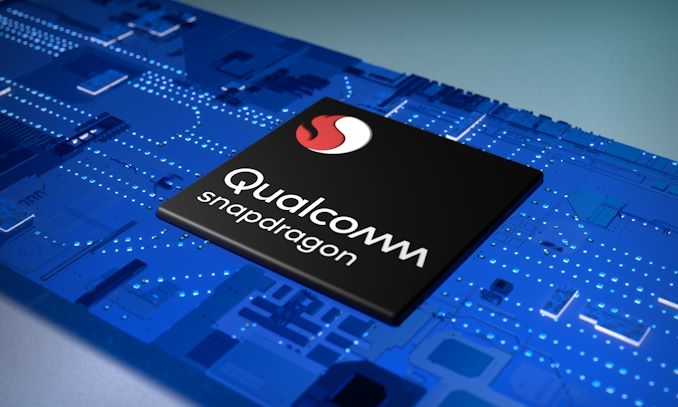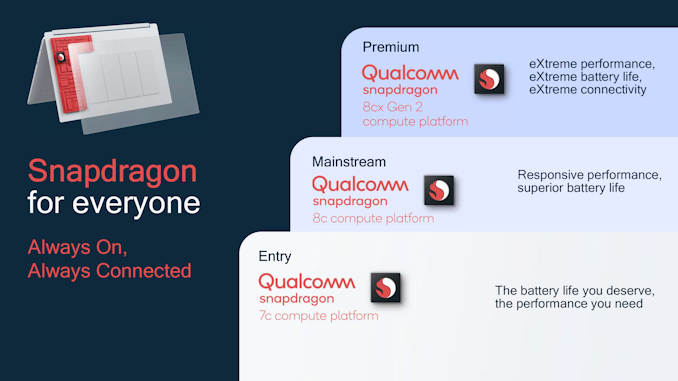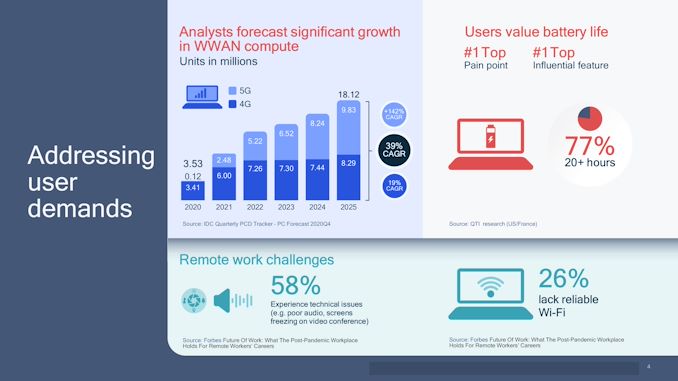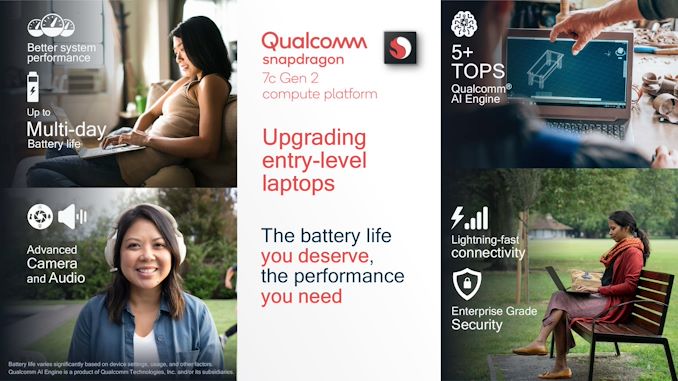Qualcomm Announces Snapdragon 7c Gen 2: Entry-Level PC and Chromebook Refresh
by Ryan Smith on May 24, 2021 11:01 AM EST- Posted in
- SoCs
- Snapdragon
- Qualcomm
- Chromebook
- Laptops
- Cortex-A76
- Snapdragon 7c

As part of their Scaling the Mobile Compute Ecosystem presentation, Qualcomm this morning is announcing a refreshed version of their Snapdragon 7c for laptops. Aptly named Snapdragon 7c Gen 2, the updated chip for entry-level Windows PCs and Chromebooks sports a slight clockspeed boost, bumping the frequency of the two Kryo 468 (Cortex-A76) cores up to 2.55GHz. Spec bumps aside, Qualcomm’s target market for the 7c family hasn’t changed, with the updated SoC designed to serve as an anchor for sub-$400 “always-on” devices.
The original Snapdragon 7c was announced back at Qualcomm’s 2019 tech summit, as part of Qualcomm’s efforts to flesh out their lineup of Snapdragon Compute SoCs aimed at Arm-powered PCs and other laptops. At the time, Qualcomm was (and still is) gunning heavily for making a market of always-on Windows devices, taking advantage of the low power consumption of Qualcomm’s chips and integrated LTE modem to deliver a mobile-like platform for Windows PCs. Those efforts, though not a smash hit, have at least proven fruitful enough for Qualcomm to refresh parts of the Snapdragon Compute lineup while better bringing Chromebooks into the fold as well.
To that end, the Snapdragon 7c is getting what amounts to a mid-generation face lift. Like the Gen 2 update for the 8cx last year, Qualcomm isn’t rolling out a new silicon design for the 7c Gen 2, but they are reaping the benefits of general yield improvements and better binning to ratchet up the clockspeeds. For the 7c Gen 2, the clockspeed on the chip’s two Cortex-A76 cores is being bumped from 2.4GHz to 2.55GHz.
| Qualcomm Snapdragon Compute SoCs | ||||
| SoC | Snapdragon 8cx Gen 2 | Snapdragon 8c | Snapdragon 7c Gen 2 | |
| CPU | 4x Kryo 495 Gold (CA76) 4x Kryo 495 Silver (CA55) Up to 3.15 GHz |
4x Kryo 490 Gold (CA76) 4x Kryo 490 Silver (CA55) Up to 2.45 GHz |
2x Kryo 468 Gold (CA76) 6x Kryo 468 Silver (CA55) Up to 2.55 GHz |
|
| GPU | Adreno 680 | Adreno 675 | Adreno 618 | |
| DSP / NPU | Hexagon 690 | Hexagon 690 | Hexagon 692 | |
| AI Perf Combined | 7 TOPs | 6 TOPs | 5 TOPs | |
| Memory Controller |
8x 16-bit CH LPDDR4X-4266 63.58 GB/s |
4x 16-bit CH LPDDR4X-4266 31.79 GB/s |
2 x 16-bit CH LPDDR4X-4266 15.90 GB/s |
|
| ISP/Camera | Dual 14-bit Spectra 390 ISP 1x 32MP or 2x 16MP |
14-bit Spectra 255 1x 32MP or 2x 16MP |
||
| Decode Encode |
4Kp120 10-bit H.265 HDR Support |
4Kp60 H.265 HDR Support |
||
| Wi-Fi | Wi-Fi 6 + BT 5.1 | Wi-Fi 5 + BT 5.0 | ||
| Integrated 4G Modem | Snapdragon X24 LTE (Category 20) |
Snapdragon X15 LTE (Category 15/13) |
||
| External 5G Modem | Snapdragon X55 (Optional) | -- | ||
| Mfc. Process | 7nm | 7nm | 8nm | |
Feature-wise, the rest of the package is otherwise the same as it was for the original Snapdragon 7c. This includes a dual-channel (32-bit) LPDDR4X memory bus, a Hexagon 692 DSP, a Spectra 255 ISP, and an LTE category 15 Snapdragon X15 modem. The 7c Gen 2 is unabashedly an entry-level platform, with Qualcomm keeping the feature set (and performance) light in order to be price-competitive in the entry-level market.
Overall then, the Snapdragon 7c Gen 2 not much of a bump over the original Snapdragon 7c, but then again Qualcomm isn’t pitching the Snapdragon 7c Gen 2 as a true next-generation successor to the original Snapdragon 7c. Instead, the launch of the 7c Gen 2 is being treated as something of a second launch for the 7c platform, while also letting Qualcomm pivot a bit on their device strategy to chase Windows devices and Chromebooks more equally. From Qualcomm’s perspective, they still have a competitive and desirable product, especially as entry-level devices have been selling like hotcakes over the past year due to the pandemic.
As with the original 7c, Qualcomm’s biggest strengths with the 7c Gen 2 platform are on battery life and the integrated LTE radio. While the performance of a pair of A76 CPU cores is nothing to write home about these days, they are rather power-efficient by PC standards. Meanwhile an integrated modem not only helps to sell the SoC to cost-conscious OEMs, but also security-minded companies that want their devices reachable the bulk of the time.
The competition for this revised SoC first and foremost remains Intel, who is now shipping their Tremont architecture-based Jasper Lake platform. Qualcomm is still looking to snag a piece of Intel’s PC pie, especially as the chip crunch has forced Intel to prioritize shipping high-end (high margin) hardware. And though Jasper Lake will undoubtedly make for stiffer competition than the older Gemini Lake platform, Qualcomm is still counting on battery life as well as their audio and video processing capabilities to give them an edge over Intel.
Wrapping things up, Qualcomm expects devices based on the Snapdragon 7c Gen 2 to be available this summer. Given the hardware similarities to the original 7c, this should make for a relatively seamless transition for Qualcomm’s OEM partners.
Source: Qualcomm



















33 Comments
View All Comments
Alistair - Monday, May 24, 2021 - link
Yeah! We're already so slow nobody wants it, so we'll release a slower product! Buy buy buy!mode_13h - Monday, May 24, 2021 - link
What's funny is these A76's would run circles around a Raspberry Pi v4, and at a fraction of the power. And let's not even start on the Pi's crap GPU!It's like I think Anand used to say: there are not bad products, only bad prices. Now, I think that assumes the product actually works as advertised, otherwise it is *indeed* a bad product.
nandnandnand - Monday, May 24, 2021 - link
Last time I checked even "budget" Snapdragon 7c devices were expensive, with 8cx being absurd.You can get a Raspberry Pi 4B with 8 GB of RAM for $75, and there are still laptops and tablets with only 4 GB at several times the price. Like the joke Galaxy Tab S7 FE that just leaked.
As far as performance goes, laptop-oriented SoCs ought to have some Cortex-X1 cores.
mode_13h - Tuesday, May 25, 2021 - link
> Last time I checked even "budget" Snapdragon 7c devices were expensive, with 8cx being absurd.By "devices", you must mean laptops? Well, they have a screen, ssd, battery, keyboard, and shell. And, while some budget chromebooks manage to do all of that for a couple hundred $, I gather the devices you've seen weren't trying to be budget.
Now, let's consider that the 7c is an older SoC. So, there could be some real incentive to offer price breaks that would make it attractive for lower-cost devices. And if you take away basically everything but a housing, RAM, the board, and a PSU, I don't see why they couldn't get within the territory where someone looking for a higher-end alternative to an 8 GB Pi v4 would start to become interested.
ikjadoon - Monday, May 24, 2021 - link
After what Qualcomm did with smart watches, I’m beginning to believe they just have very low internal bandwidth. They can work on maybe 3-5 new SoCs a year (even as they occupy 7+ markets: phones, tablets, smartwatches, notebooks, modems, IoT, smartphone, automotive, etc.).Mediatek’s newly announced CPUs are seemingly much more performant. ;( Qualcomm should at least try to compete at the high-end, instead of ceding it to MT.
MT8192: 4x A76, 4x A55
MT8195: 4x A78, 4x A55
Perhaps by December 2021 at Qualcomm’s summit, we’ll have a proper “8cxx”. I hope they can pull off one proper refresh before NUVIA’s Phoenix.
Qualcomm’s naming system is just confusing. You know, Apple’s “M1” and Ampere’s “Q80-33” (80 cores, 3.3 GHz) are far improved.
foremi - Monday, May 24, 2021 - link
Qualcomm doesn't need to compete with others because they have no competition / a monopoly in the US due to patents.So why would they suddenly be compelled to put energy into a new, undeveloped market with unknown capability with no way to monopolize it? I would not expect anything but the bare minimum for a flagship phone soc from qualcomm.
mode_13h - Monday, May 24, 2021 - link
I can understand people hating on Qualcomm, as a business. But, they *do* make SoCs with the best cores ARM has to offer. And their GPUs aren't half bad, either.nico_mach - Tuesday, May 25, 2021 - link
I think you're confusing them with Apple. Their pricing isn't based on performance, but on telecom patents. They should be more interested in investing in the future, ie, competing sincerely for the PC/Tablet business. They haven't been.mode_13h - Wednesday, May 26, 2021 - link
> They should be more interested in investing in the futureEvery time they try, it seems they get threatened with lawsuits by activist investors.
mode_13h - Monday, May 24, 2021 - link
> Qualcomm should at least try to compete at the high-end, instead of ceding it to MT.Have you heard of the Snapdragon 888?